List of Gaudí buildings facts for kids
| UNESCO World Heritage Site | |
|---|---|
| Includes |
|
| Criteria | Cultural: (i)(ii)(iv) |
| Inscription | 1984 (8th Session) |
| Extensions | 2005 |
Antoni Gaudí (born in Catalonia, Spain) was a super creative architect. He was part of a special art movement called Modernisme, also known as Art Nouveau. Gaudí was famous for his truly unique style. His buildings look like they came from a dream! Each design was very individual and imaginative.
Gaudí studied architecture in Barcelona from 1873 to 1877. He didn't always get the best grades. But he was amazing at drawing and designing projects. After five years of hard work, he became a qualified architect in 1878.
When his degree was signed, someone joked, "Who knows if we have given this diploma to a nut or to a genius. Time will tell." It turns out, he was definitely a genius! Gaudí started designing right away. He stayed connected to his school throughout his life.
Contents
Gaudí's Amazing Buildings
Antoni Gaudí created many incredible buildings during his lifetime. These structures are famous all over the world. They show off his special way of mixing nature, art, and architecture.
The Sagrada Família: A Never-Ending Masterpiece
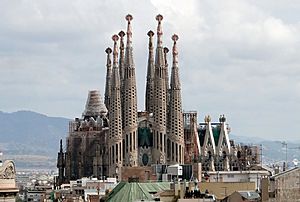
One of Gaudí's most famous projects is the Sagrada Família in Barcelona. He started working on it in 1883. This huge church is still being built today, over 140 years later! Gaudí designed the crypt, the apse, and the beautiful Nativity façade. It's a truly amazing sight.
Other Famous Works
Gaudí designed many other fantastic buildings. Each one has its own story and unique features.
- Park Güell (1900-1914): This magical park in Barcelona feels like a fairy tale. It has colorful mosaics, unique stone structures, and amazing views. It was originally planned as a housing estate, but it became a public park instead.
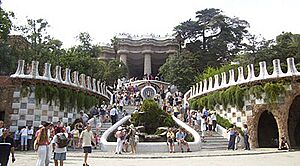
- Casa Vicens (1883-1888): Located in Barcelona, this was one of Gaudí's first important houses. It features bright colors and interesting patterns. It looks like a mix of different styles.

- Palau Güell (1885-1890): This grand palace in Barcelona was built for Eusebi Güell, a wealthy businessman who supported Gaudí. It has a stunning main hall and unique chimneys on the roof.
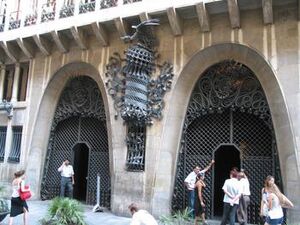
- Casa Batlló (1904-1906): Also in Barcelona, this house is often called the "House of Bones" because of its unusual design. It has wavy lines, colorful tiles, and balconies that look like masks.
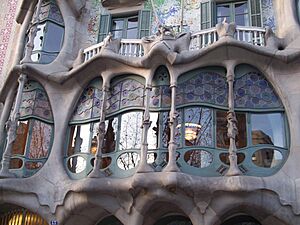
- Casa Milà (1906-1912): Known as "La Pedrera" (The Stone Quarry), this apartment building in Barcelona has a wavy stone facade. It looks like a natural rock formation. The roof is famous for its sculptural chimneys.
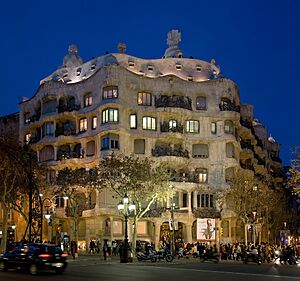
- Church of Colònia Güell (1908-1914): This church, located near Barcelona, was never fully finished. However, its crypt is a masterpiece. It shows Gaudí's innovative ideas about structure and light.
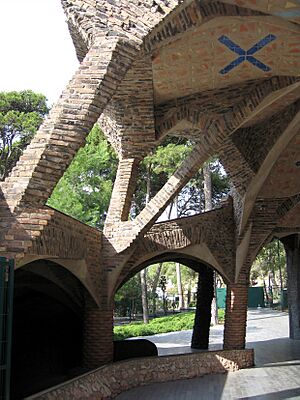
- El Capricho (1883-1885): This colorful and playful house is in Comillas, Cantabria. It has sunflower tiles and a tower that looks like a minaret.
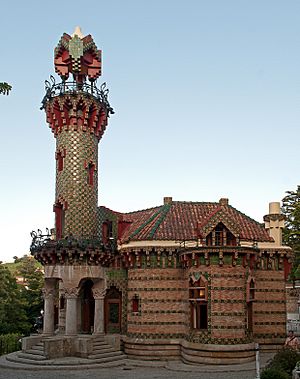
- Episcopal Palace of Astorga (1883-1893): This castle-like palace in Astorga was designed for a bishop. It has a medieval feel mixed with Gaudí's unique touches.
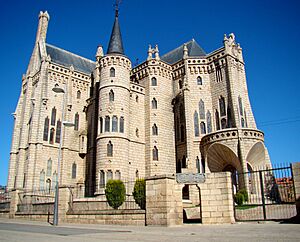
- Casa Botines (1891-1892): Located in León, this building looks like a medieval fortress. It served as a residential building and a warehouse.
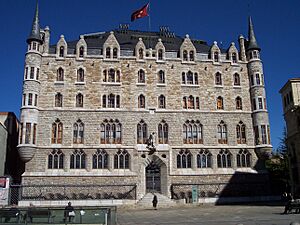
Designs That Never Were
Gaudí also created designs for buildings that were not fully built. These plans show how imaginative he was, even for projects that never came to life.
- Franciscan Missions in Tangier (1892): Gaudí designed a grand church and school complex for Tangier, Morocco. It was a very ambitious project, but it was never built.
- Hotel Attraction (1908): Imagine a hotel in New York City designed by Gaudí! He created plans for a huge, unique skyscraper. It would have been an amazing landmark, but it remained a dream.
Gaudí's Legacy: UNESCO World Heritage Sites
Antoni Gaudí's work is so special that UNESCO has recognized seven of his buildings as World Heritage Sites. These sites are all located in the Province of Barcelona, Spain. They are celebrated for their outstanding universal value and unique artistic style.
Here are the amazing Gaudí buildings included in the UNESCO list:
- Parque Güell
- Palacio Güell
- Casa Mila
- Casa Vicens
- Nativity Façade and Crypt of the Sagrada Familia
- *Other parts of the Sagrada Familia, including the Sagrada Família Schools, are also important. They are part of the protected area around the main site.
- Casa Batlló
- Crypt at the Colònia Güell
- The area around the Crypt at Colònia Güell, including the Torre Salvana, is also protected.
-
1. Park Güell
-
2. Palau Güell
-
3. Casa Milà
-
4. Casa Vicens
-
6. Casa Batlló
-
7. Cripta Güell
Images for kids
-
The unique architecture of Bodegas Güell.
-
The elegant facade of Casa Calvet.
-
The historic Bellesguard tower.
-
The beautiful Artigas Gardens.
-
The Sagrada Família Schools, designed by Gaudí.


















